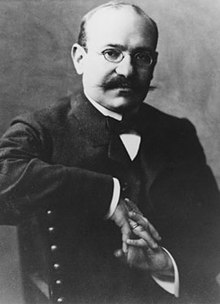Gustav Aschaffenburg
Gustav Aschaffenburg (born May 23, 1866 in Zweibrücken , † September 2, 1944 in Baltimore ) was a German psychiatrist. He is considered one of the pioneers in forensic psychiatry and criminology .
life and work
He was the son of Gustav Aschaffenburg and studied at the universities of Heidelberg, Würzburg, Freiburg i.Br., Berlin and Strasbourg, where he received his doctorate in 1890. med. received his doctorate. From 1891 he worked as an assistant to Emil Kraepelin at the newly founded Psychiatric University Clinic in Heidelberg . In Heidelberg he became a member of the Freemason Lodge for Truth and Faithfulness . After his habilitation in 1895, he followed a call to the University of Halle in 1901 and in 1904 to the newly founded Academy for Practical Medicine in Cologne , which became part of the University of Cologne in 1919 . His senior physician, who later became a psychiatrist, Kurt Schneider, completed his habilitation there in 1919 . From 1906 he was the chief doctor of the Lindenburg insane asylum , today Cologne University Hospital . From 1928 on, he headed their criminal science institute. Aschaffenburg was among other things editor of the monthly for criminal psychology and criminal law reform . Aschaffenburg's academic activity in Cologne came to an abrupt end in 1933, when the new National Socialist government passed the law to restore the civil service , after which he was dismissed from civil service as a Jew (although he was baptized as a Protestant in 1899). Max de Crinis from Graz , a member of the NSDAP and staunch anti-Semite , was appointed as his successor . Aschaffenburg also had to give up its editorial work in 1935.
After his medical work was also restricted, Aschaffenburg emigrated to the USA via Switzerland in 1938 and was professor of psychiatry at the Johns Hopkins University in Baltimore, Maryland.
Gustav Aschaffenburg's main work, The crime and its combat (1903, 3rd edition 1923), was the authoritative German-language criminological textbook until the thirties of the twentieth century.
Works (selection)
- Hoche A, with the help of Aschaffenburg (G), Schultze (E), Wollenberg (R). Handbook of Forensic Psychiatry . Berlin, A. Hirschwald 1901 (2nd edition 1909, 3rd edition 1934)
- The crime and its fight , Heidelberg 1903 (2nd edition 1906, 3rd edition 1923)
- Aschaffenburg G. On the mood swings of epileptics (collection of informal treatises from the field of nervous and mental diseases, edited by Hoche A, volume 7, issue 1). Halle, C. Marhold, 1906
- Aschaffenburg G, Ed. Handbuch der Psychiatrie (28 parts in 21 volumes). Leipzig - Vienna, F. Deuticke, 1911–1927
- Securing society against the publicly dangerous mentally ill: results of a study trip commissioned by the Holtzendorff Foundation , Berlin 1912
- Psychiatry and Criminal Law , 1928
literature
- Dorothea Seifert: Gustav Aschaffenburg as a criminologist , Freiburg 1981
- Reichs Handbuch der Deutschen Gesellschaft - The handbook of personalities in words and pictures , first volume, Deutscher Wirtschaftsverlag, Berlin 1930, p. 39, ISBN 3-598-30664-4
- Richard Wetzell: Inventing the Criminal. A History of German Criminology 1880–1945 , Chapel Hill and London 2000
- Magnus Schmid: Aschaffenburg, Gustav. In: New German Biography (NDB). Volume 1, Duncker & Humblot, Berlin 1953, ISBN 3-428-00182-6 , p. 410 ( digitized version ).
Web links
- Literature by and about Gustav Aschaffenburg in the catalog of the German National Library
- Entry on Gustav Aschaffenburg in the Catalogus Professorum Halensis
Individual evidence
- ↑ Volker Roelcke : Schneider, Kurt. In: Werner E. Gerabek , Bernhard D. Haage, Gundolf Keil , Wolfgang Wegner (eds.): Enzyklopädie Medizingeschichte. De Gruyter, Berlin / New York 2005, ISBN 3-11-015714-4 , p. 1304.
- ^ Richard Wetzell, Inventing the Criminal - A History of German Criminology 1880-1945 , Chapel Hill and London 2000, p. 63
| personal data | |
|---|---|
| SURNAME | Aschaffenburg, Gustav |
| BRIEF DESCRIPTION | German psychologist |
| DATE OF BIRTH | May 23, 1866 |
| PLACE OF BIRTH | Zweibrücken |
| DATE OF DEATH | September 2, 1944 |
| Place of death | Baltimore |
